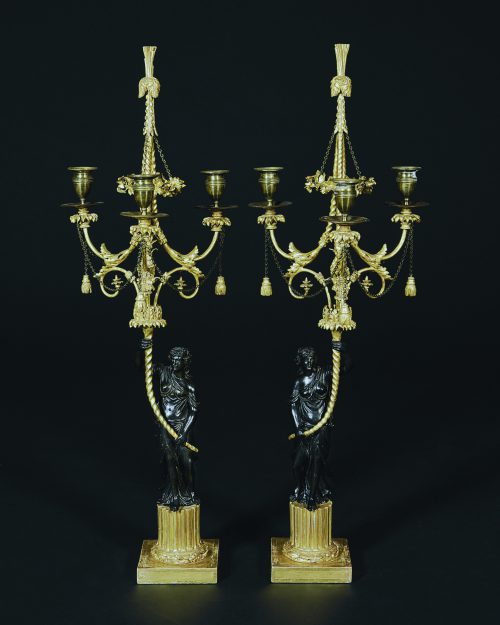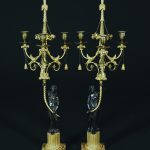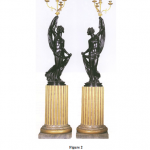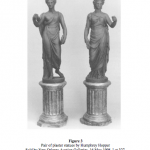9811 A VERY RARE PAIR OF NEOCLASSICAL GILTWOOD AND BRONZED CANDELABRA Almost Certainly English. Last Quarter Of The Eighteenth Century. Measurements: Height: 36 ¼” (92.1 cm) Width: 12” (30.5 cm) Depth: 12” (30.5 cm)

-
Figure 1
-
Figure 2
-
Figure 3
Research
Of giltwood with faux bronze decoration and gilt-brass candleholders. Each candelabrum with an elegantly modeled draped female classical full-length figure holding aloft a spirally-carved cornucopia from which issue three inverted voluted supports on which rest three downswept acanthine candle arms ending in brass ribbed cup-shaped candleholders. The foliate carved shaft ending in carved foliate plumes from which are suspended three gilt-brass chains which carry a carved giltwood wreath. Each candelabrum raised on a laurel carved giltwood fluted cut column base resting on a square faux bronze plinth base. Gilding and bronzing original.
Provenance:
A Prominent New York Fifth Avenue Collection
An Important German Collection
Jeremy Ltd., London
The present pair of candelabra, although almost certainly English, due to their lightness of modeling, gilding technique, and typically English vase-shaped brass candleholders, are based on a French prototype (figure 1) dating from the late 18th century. It is likely that the pair, which are most unusually carved in fine detail from wood, were produced as special commissions, or as maquettes for the plaster sculpture industry that flourished in Britain from the mid-18th through the mid-19th century.
The sculptor John Cheere (1709-87) appears to have been the first to sell plaster casts as decorative art, after becoming owner of a sculpture yard at Hyde Park Corner around 1738. Having developed methods of bronzing and gilding plaster, and of painting it to imitate marble, Cheere was able to mass-produce busts and statuettes of high-quality appearance. The rising demand for neoclassical statuary in private homes in England made Cheere’s work very popular, and soon numerous competing plaster shops sprang up in London.
The plaster sculpture movement never spread to the Continent, although a very influential set of French statuettes were first produced in plaster for a grande fête at the home of Madame du Berry in 1771. These four figures of Abundance held cornucopias from which issued candlelight. Marble versions of the du Barry lamps were shown at the Paris Salon in 1773, inspiring a new taste in neoclassical figural candelabra throughout France and England.
By the early years of the 19th century, the demand among wealthy patrons in England was so great that sculptors such as Robert Shout and Humphrey Hopper began to make a specialty out of small- to medium-scale sculptures in plaster of neoclassical maidens fitted as lamps. The plaster figures, painted black in imitation of patinated bronze, typically held a cornucopia or other vessel from which issued scrolling candle arms, and in some cases stood on a faux bronze pedestal. A pair of candelabra in this style, signed by Robert Shout, were sold by Bukowski Auctions in Stockholm in November, 1998 (figure 2). The Shout pair have fluted giltwood pedestals that are very similar to those of the present candelabra.
Robert Shout worked with his father Benjamin in the family’s sculpting business, which is known to have been active between 1778 and 1823. Although Benjamin and Robert collaborated on commissions for large pieces such as monuments and busts, Robert also produced light fittings independently. A bill sent to Lord Monson in 1805, and pictured in Country House Lighting,1 has an elaborate heading that includes advertising for the younger Shout’s workshop and show rooms: it “respectfully informs the Nobility & Gentry that he has ready for Inspection & Sale… a large Assortment of Figures & Tripods for holding Lamps or Candles, of various Patterns & Dimensions, fitted up in a new & fashionable Style.” The bill also describes one of the items that Lord Monson bought as “One Pair bronz’d Vestals with 2 light patent fountain Lamps.” In fact, a number of lamps of this style, signed by Robert Shout, are known, including the pair sold at Bukowski Auctions in 1998, and a pair made for Spencer House, London, dated 1818.
The other English sculptor most known for figural lamps in the neoclassical style was Humphrey Hopper (1767-1834). Hopper came to prominence after winning the Gold Medal from the Royal Academy in 1803, for his sculptural group The Death of Meleager. Hopper found his niche in creating smaller pieces, including lamps in the “vestal virgin” style. An example of Hopper’s work of this type was sold at New Orleans Auction Galleries in May 1998 (figure 3).
As only two pairs of the present model are known to exist, it seems very likely that they are extremely rare examples of maquettes relating to the hitherto obscure plaster cast industry in England, which has become a source of much academic interest, due to Timothy Clifford’s important essay, “The Plaster Shops of the Rococo and Neo-Classical Era in Britain,” which was published in the Journal of the History of Collections in 1992.2
Footnotes:
1. Leeds City Art Galleries. Country House Lighting 1660-1890. Leeds City Art Galleries, 1992. 134. Fig. 87.
2. Clifford, Timothy. “The Plaster Shops of the Rococo and Neo-Classical Era in Britain”. Journal of the History of Collections. Vol. 4, No. 1. 1992. 39-65.




Comments are closed.